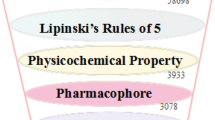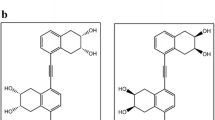Abstract
In the field of brassinosteroids, which are potent plant growth regulators, we have developed a quantitative structure-activity relationship study to develop knowledge from a structural point of view and to find out new requirement definitions. This will help identify other suitable active brassinosteroid derivatives with a good activity/synthetic cost ratio for further application in agriculture. The methodology used to achieve this goal represents a multidisciplinary study involving synthesis, molecular modeling calculations, and bioactivity evaluation. The influence of different molecular properties in the bioactivity of a set of synthetic compounds (i.e., molecular electrostatic potential and the ability to form H bonds) is discussed. The molecular electrostatic potential is expressed in terms of the electrostatic Carbó similarity index (Cl) between brassinolide (1) and other brassinosteroids. We have found that the electrostatic charges of the functional groups play an important role in the description of the activity, as evidenced by its good correlation with the Cl in most cases. Deviation from this rule could be explained by the H bonding abilities of some of these compounds, which we believe may play an essential role in binding to the natural receptors.
Similar content being viewed by others
Abbreviations
- CI:
-
electrostatic Carbó similarity index
- 3D:
-
three-dimensional
References
Brosa, C. (1997) Biological Effects of Brassinosteroids, in Biochemistry and Functions of Sterols, (Parish, E.J., and Nes, D., eds.) pp. 201–220, CRC Press, Inc. Boca Raton.
Cutler, H.G., Yokota, T., and Adam, G. (1991) Brassino-steroids: Chemistry, Bioactivity & Applications (ACS Symposium Series 474), American Chemical Society, Washington, D.C.
Adam, G., Porzel, A., Schmidt, J., Schneider, B., and Voigt, B. (1996) New Development in Brassinosteroid Research, in Studies in Natural Products, Stereoselective Synthesis (Part K), (Atta-ur-Rahman, ed.) pp. 495–549, Elsevier Science B.V., Amsterdam.
Takeno, K., and Pharis, R.P. (1982) Brassinosteroid-Induced Bending of the Leaf Lamina of Dwarf Rice Seedlings: An Auxin-Mediated Phenomenon, Plant Cell Physiol. 23, 1275–1281.
Wada, K., Marumo, S., Abe, H., Morishita, T., Nakamura, K., Uchiyama, M., and Mori, K. (1984) A Rice Lamina Inclination Test. A Micro-Quantitative Bioassay for Brassinosteroids, Agric. Biol. Chem. 48, 719–726.
Thompson, M.J., Meudt, W.J., Mandava, N.B., Dutky, S.R., Lusby, W.R., and Spaulding, D.W. (1982) Synthesis of Brassinosteroids and Relationship to Plant Growth-Promoting Effect, Steroids 39, 89–105.
Takatsuto, S., Yazawa, N., Ikekawa, N., Takematsu, T., Takeuchi, Y., and Koguchi, M. (1983) Structure-Activity Relationship of Brassinosteroids, Phytochemistry 22, 2437–2441.
Brosa, C., Nusimovich, S., and Peracaula, R. (1994) Synthesis of New Brassinosteroids with Potential Activity as Antiecdysteroids, Steroids 59, 463–467.
Brosa, C., Zamora, I., and Capdevila, J.M. (1996) Brassinosteroids: A New Way to Define the Structural Requirements, Tetrahedron 52, 2435–2448.
Ferrer, J.C., Lalueza, R., Saavedra, O., and Brosa, C. (1990) Short Step Synthesis of (22E,24R) 5α-Ergosta-2,22-dien-6-one, A Key Intermediate for the Preparation of 24-Epibrassinolide, Tetrahedron Lett. 27, 3941–3942.
Brosa, C., Peracaula, R., Puig, R., and Ventura, M. (1992) Use of Dihydroquinidine 9-O-(9′-Phenanthryl) Ether in Osmium Catalyzed Asymmetric Dihydroxylation in the Synthesis of Brassinosteroids, Tetrahedron Lett. 33, 7057–7060.
Brosa, C., Puig, R., Comas, X., and Fernández, C. (1995) New Synthetic Strategy for the Synthesis of 24-Epibrassinolide, Steroids 61, 540–543.
Brosa, C., Soca, L., Terricabras, E., Ferrer, J.C., and Alsina, A. (1997) New Synthetic Brassinosteroids: A 5α-Hydroxy-6-ketone Analog with Strong Plant Growth-Promoting Activity, Tetrahedron, in press.
Brosa, C., Soca, L., Terricabras, E., and Zamora, I. (1996), Brassinosteroids: Looking for a Practical Solution, Proc. Plant Growth Regul. Soc. Am. 23, 21–26.
Brosa, C., Terricabras, E., Zamora, I., Peracaula, R., Rodríguez-Santamarta, C., Masó, M., and Modolell, A. (1997) The Effect on the Activity of Different Functionalities in Brassinosteroids’ B ring, Tenth European Symposium on Organic Chemistry, 57 Congress, Basel.
Brosa, C., Zamora, I., Puig, R., and Teixidó, J. (1997) Molecular Similarity Matrices in QSAR for Flexible Compounds. Quant. Struct.-Activity Relat., in press.
Carbó, R., Leyda, L., and Arnau, M. (1980) An Electron Density Measure of the Similarity Between Two Compounds, Int. J. Quantum Chem. 17, 1185.
ASP V3. 11, Oxford Molecular Ltd. (1995) Magdalen Center, Oxford Science Park, Sandford on Thames, Oxford-OX4 4GA, England.
Goodford, P. (1995) GRID Molecular Discovery Ltd., Oxford, England.
Author information
Authors and Affiliations
Corresponding author
About this article
Cite this article
Brosa, C., Zamora, I., Terricabras, E. et al. Synthesis and molecular modeling: Related approaches to progress in brassinosteroid research. Lipids 32, 1341–1347 (1997). https://doi.org/10.1007/s11745-006-0173-2
Received:
Revised:
Accepted:
Issue Date:
DOI: https://doi.org/10.1007/s11745-006-0173-2




